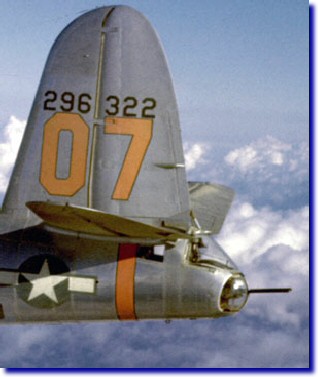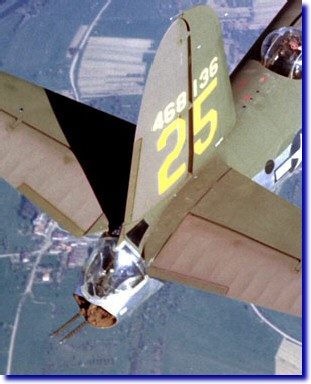![]()
Armament
|
|
|
|
"In 1945 the Luftwaffe fighters would still come after us, but would avoid it if at all possible. Because we could fly such tight formations and the degree of firepower that we had, it would be nothing but 'lead soup' for them." -Ben Reisdorf, 441st Bomb Squadron |
|
|||
|
|
The Martin 250CE full-power turret was located forward to the waist gun and just aft of the rear bomb bay. It was designed as a "drop in" unit and was hung from the upper fuselage. The unit rotated on a large ball bearing ring. It weighed 655 lbs, was 6 /12 feet tall, 4 ft. in diameter, and had a 3/8" protective armor plate skirt that rotated with the turret to provide protection to the gunner. The .50-caliber guns & mount, controls, site, and cartridge canisters (400 r.p.g.) were all a part of the unit. It featured a drop seat the was brought up and latched once the gunner lifted himself into position. Power was derived from a General Electric amplidyne motor.
Operating the turret was fairly intuitive. There were two hand grips. A rocking motion fore and aft adjusted gun angle and lateral movement was performed by twisting of the handgrips with handle displacement being converted to rate of rotation. Both movements could be performed simultaneously to created a diagonal swath of fire. Triggers were located on both grips and activation of either fired the guns. Azimuth was a full 360 degrees with up to an 85 degree elevation. To protect the vertical stabilizer, there were fire interrupter cams that ceased gunfire if guns were aimed near the Marauder's tail. Similarly, fire interrupters were set to give a 4 inch clearance for the propeller arcs an wing tips that under full flight loads could flex up to 6.8 inches. |
||
|
|||||||||||||||||||||||
|
|
|
||||||||||||||||||||||
|
|
|
|
A flexible mount for a single .30-caliber designed to fire through the rear crew entry hatch was introduced in the earliest B-26 models, the so called "tunnel" gun. This was in response to complaints about the lack of downward defensive firepower. Two waist .30-caliber waist guns were also added to the earlier models. The "B-26B-1" did away with the single ventral gun and had waist positions augmented. Waist windows were located on each side of the aft fuselage. Each window now had a single .50 Browning M-2 Machine gun. The guns were mounted on swivels. Ammunition canisters were mounted on the fuselage ceiling with the belts running down to the guns. Sliding hatches covered the waist openings when not in use. With the B-26C-5-MO, the side waist gun doors were enlarged and moved one station aft to improve the angle of fire down and to the front. Also with this model, a single larger circular scanning window, replacing the two smaller ones, was located above each waist door to give the gunner a better view. |
|
|
|
|
Starting with the B-26B-4 variant, four forward facing .50-caliber fixed guns were mounted in blisters on each side of the fuselage below the radio operator and navigator's compartment. Ammunition was fed from inside the fuselage. Armament with the B-26-4 now totaled 12 Colt-Brownings, giving the Marauder as much firepower as a fighter. |
|
|
|
|
Starting with the "B-26B-1" a flexible machine gun was mounted in the center of the nose with a canvas bag under the breech to collect the shell casings. Ammunition hung in a box from the right side of the nose frame. The weapon could be hooked to a clasp on the left to keep it our of the way while the bombardier was over the bomb sight. In addition, the "B-26B-1" had a fixed forward-firing .50-caliber installed in the lower right-hand side of the nose.
The fixed .50-caliber machine gun in the nose was deleted in the middle of the B-26B-45-MA/B-26C-45-MO production run (from 42-95979). |
|
|||||||||
|
|
|
||||||||

Copyright(c) 2006 320th History Preservation. All rights reserved.



















 The
Martin 250CE Full Power Turret
The
Martin 250CE Full Power Turret
 The B-26A
The B-26A


